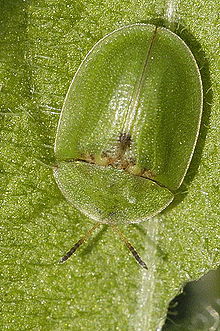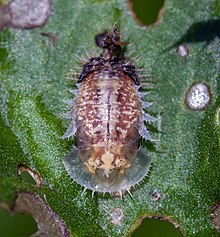Thistle tortoise beetle
| Thistle tortoise beetle | |
|---|---|

| |
| Scientific classification | |
| Domain: | Eukaryota |
| Kingdom: | Animalia |
| Phylum: | Arthropoda |
| Class: | Insecta |
| Order: | Coleoptera |
| Infraorder: | Cucujiformia |
| Family: | Chrysomelidae |
| Genus: | Cassida |
| Species: | C. rubiginosa
|
| Binomial name | |
| Cassida rubiginosa Müller, 1776 [1]
| |
The thistle tortoise beetle (Cassida rubiginosa) is a species of beetle in the subfamily Cassidinae (tortoise beetles) and the genus Cassida. The thistle tortoise beetle can be recognized by its green, rounded back and it can be found on thistle plants in many regions of North America and Europe. The thistle tortioise beetle was first discovered in 1902 in Lévis, Quebec. In 1931, Nellie F. Paterson was the first to document the mature larva. Later, the instar larva of this species was first recorded in 2004 by Jolanta Świętojańska. The thistle tortoise beetle exhibits multiple defense behaviors, such as a flexible shield, providing a barrier against the mandibles of predators, and an excretion that protects the eggs as well.
Its ability to massively consume and damage
Description

The thistle tortioise beetles measure 6.0–8.0 mm in length. Like all Cassida, its head is covered by the
Taxonomy
The thistle tortoise beetle belongs to the
Distribution and habitat
This beetle inhabits North America and can be commonly found from South Dakota to Virginia within the United States. In Canada, it is found across several provinces, spanning from Alberta to New Brunswick. In Europe, it can be encountered from Fennoscandia to Greece and Spain. It is also found in Great Britain and across Siberia.[4]
In these regions, they live in areas where there are plenty of thistle. For example, these can include fields,
Ecology
Diet
C. rubiginosa feeds on various Asteraceae, including thistles and many others.

Thistle beetle larvae mainly stay on the leaves they were hatched on throughout their development and feed on them.[4] The adults are usually found on the underside of the leaves and the larvae on the uppersides. The time it takes for them to begin feeding depends on a few factors relating to the leaf's structure. The larvae wait until the thistle plants grow by 30% and for the nitrogen levels in the leaves to drop by 50% before feeding. The time that they start feeding also affects the growth of the thistle plant. The plant's upward-growing capability is inhibited when feeding starts late in the season. However, no effect on the plants is detected when feeding begins in the early season.[6] '
Adult feeding can damage the leaves more significantly than larvae feeding since they do not begin eating from the edges of the leaf but instead begin at the center and eat down from the surface.[4]
Adults may also feed on pollen of
The beetle's consumption of these plants is facilitated by a
Predators
As the larvae develop, they develop a shield with its feces to protect itself from danger. This protection mechanism is possible because of lateral spines, which can form a shield. It was found that this shield has the capability to protect different areas of the body by moving to areas that sense danger.
Parasites
Another prominent parasite that affects these beetles is Eucelatoria dimmocki. They are a type of fly found in Virginia and Maryland. In some regions such as Maryland, these parasites accounted for almost 20% of total parasitism.[17] They target larvae and pupae. In Europe, the most prominent parasite of thistle beetle larvae and pupae that accounts for 96% of total parasitism are Hexamermis species[4]
Behavior
Parental care
Adult thistle beetles are
Soon after the eggs are laid, a layer of
Migration
During the fall, it has been observed that these beetles migrate to the
Reproduction
Life cycle

The
There are five stages of larval development called instars. As with hatching rate, larvae development is temperature-dependent and shows a positive relationship with increasing temperature. It was also found that larvae develop faster during shorter days compared to longer days. Additionally, male larvae usually develop faster than female larvae.[21]

Larvae remain on thistle leaves that were laid only throughout their development. Once ready, they move to the central portion of the leaf, which is thicker, for pupation. Pupation length depends on the temperature, and it was shown that it ranges from around 3 days to 10 days depending on the temperature. Higher temperatures nearing 32°C led to a shorter pupation period.[15] Between July and August, adults begin to appear.[22]
As biological control

Thistle plants are known for their very fast-growing ability, which can quickly overpower local agriculture. They have few predators and are hard to kill through human activity due to their fast seed production.
Cassida rubiginosa was introduced to

Some states in the United States where thistle beetles are used as biological control agents are Virginia and Maryland. Significant results were seen in Maryland where musk thistle seed production was reduced by 72%. Flowering was inhibited after introducing thistle beetles to populations of thistle plants.[17] In Virginia, it was found that thistle growth was affected the most when more than 50% of leaf foliage was consumed.[26] In dry years in Virginia, five parasite-free beetles per plant have been shown to reduce above ground thistle biomass by 88%, with only 25% of these plants surviving to the end of the following year. In wet years the impact was less but still substantial.[24]
Thistle beetles as a biological control were also widely used in Canada. In the province of Saskatchewan, thistle beetles were able to defoliate thistles in the region.[17] In other regions of Canada, such as in the province of Quebec, it was found that these beetles were not sufficient in helping reduce thistle populations.[9] One possible explanation for this was that parasitism was a challenge due to parasites preventing large populations of thistle beetles from thriving.[14] It was found that parasites that inhibited the accumulation of thistle beetles when used as biological control agents were Tetrastichus rhosaces, Eucelatoriopsis dimmocki, Spilochalcis albifrons, Eupelmella vescicularis, and Itoplectis conquisitor.[15][27][28]
References
- ^ "Cassida rubiginosa". Integrated Taxonomic Information System.
- ISBN 978-1-908819-08-6.
- ^ "Species Cassida rubiginosa - Thistle Tortoise Beetle". bugguide.net. Retrieved 27 August 2018.
- ^ .
- ^ ISSN 0003-0090.
- ISSN 1938-2901.
- ^ "Cassida rubiginosa Müller, O.F., 1776". UK Beetle Recording (NERC- Centre for Ecology & Hydrology). Retrieved 27 August 2018.
- PMID 29153832.
- ^ JSTOR 1940069.
- ^ ISSN 0021-8790.
- S2CID 23033169.
- ^ Engel, H (1935). "Biologie und Ökologie von Cassida viridis L. Zeitschrift für die Morphologie und Ökologie der Tiere". Journal of the Morphology and Ecology of Animals.
- S2CID 55169132.
- ^ S2CID 84695151.
- ^ ISSN 0749-8004.
- ^ Ward, R.H. (1975). "Cassida rubiginosa Müller (Coleoptera: Chrysomelidae), a potential biocontrol agent of thistles in Virginia". Journal of the New York Entomological Society. 83 (247).
- ^ ISSN 1938-2936.
- S2CID 84283462.
- ^ JSTOR 1940069.
- PMID 29279866.
- ^ Kosior, Andrzej (1975). "Biology, Ecology, and Economic Importance of Cassids (Coleoptera, Chrysomelidae, Cassidinae) of the Ojców National Park". Acta Zoologica Cracoviensia. 20.
- S2CID 85775050.
- ^ "Beetles to battle $32m-a-year thistle problem". The Southland Times. Retrieved 22 November 2011.
- ^ a b "THE BIOLOGICAL CONTROL OF WEEDS BOOK: GREEN THISTLE BEETLE" (PDF). TE WHAKAPAU TARU. 2010. Retrieved 27 August 2018.
- ^ "The great beetle swap". Auckland Council. 7 December 2016. Retrieved 27 August 2018.
- . Retrieved 2024-02-29.
- PMID 37450765.
- ISSN 0749-8004.
External links
- Global biodiversity information
 Data related to Cassida rubiginosa at Wikispecies
Data related to Cassida rubiginosa at Wikispecies
